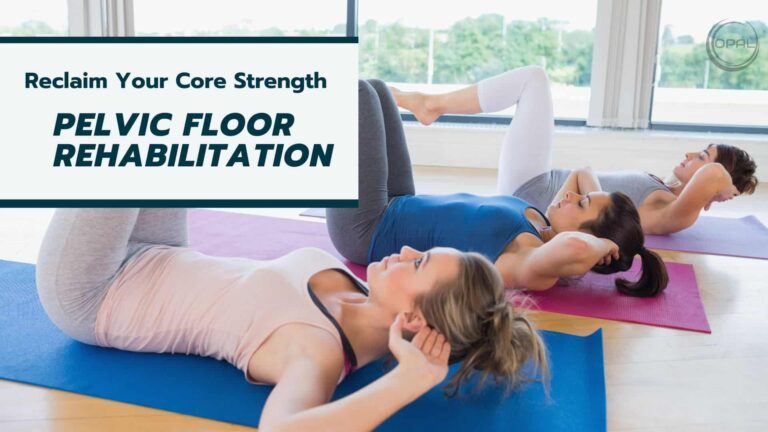Top 5 Effective Pelvic Floor Exercises for Weak Pelvic Floor in Supine Position
A strong pelvic floor is essential for overall health, but many people forget about this when exercising. Pelvic floor exercises can make a difference if you have just had a baby, are aging, or want a strong core. For those with a weak pelvic floor, starting exercises in a supine position (lying on your back) can be comfortable and effective.
The following guide will take you through the top 5 pelvic floor exercises you can perform while lying down. These exercises are perfect for beginners or those recovering from pelvic floor issues. They are also ideal when you need a low-impact workout or want to include these essential exercises in your bedtime routine.
These exercises are designed to target and strengthen the pelvic floor muscles. Whether you’re dealing with urinary incontinence or pelvic organ prolapse or want to maintain pelvic health, starting these exercises can make a big difference.
Let’s look at these easy-to-follow yet highly effective pelvic floor strengthening exercises, which you can do from the comfort of your bed or yoga mat.
Key Takeaways
- Pelvic floor exercises are crucial for overall health, especially after childbirth, during aging, or for core strength.
- Supine position (lying on your back) is ideal for beginners, as it helps isolate pelvic floor muscles without added stress from gravity.
- The top 5 pelvic floor exercises in the supine position are:
- Kegels: The foundation of pelvic floor training
- Diaphragmatic breathing: Connects breath with pelvic floor function
- Bridging exercise: Works pelvic floor, core, and glutes simultaneously
- Knee fallout: Improves pelvic floor control and stability
- Marches (toe taps): Challenges pelvic floor stability while engaging core and hip flexors
- A sample workout includes all five exercises performed 3-4 times a week.
- Consistency, quality of form, and patience are key to success, with noticeable improvements typically occurring after 6-8 weeks.
- Consult a pelvic floor physical therapist for personalized advice, especially if experiencing ongoing issues or after pelvic surgery.

So, what is the big deal about this pelvic floor?
Before we get to the exercises, let’s talk about the pelvic floor and why it’s such a big deal.
- First, men and women have pelvic floors, so it’s relevant to everyone.
- Second, these muscles support essential organs like the bladder, uterus in women, prostate in men, and rectum.
- Third, pelvic floor issues can cause uncomfortable symptoms that affect your quality of life. While these issues can be embarrassing, they’re more common than you think.
The good news is that, like any other muscle group in your body, your pelvic floor can be strengthened with targeted exercises. Our five pelvic floor exercises, which you can do in a lying-down pose, are a great place to start.

So why exercise in supine? For weak pelvic floor
You might be wondering why we’re focusing on supine exercises. “Supine” means lying on your back, and this position offers several benefits for pelvic floor muscle training:
- This is a comfortable position for most people, and it helps them focus on the exercises.
- In this position, gravity isn’t pulling down on your pelvic organs, which helps isolate and engage the pelvic floor muscles without adding stress.
- It helps develop better body awareness, and you can more efficiently feel the tightening and relaxation of your pelvic floor muscles.
- Any supine pelvic floor exercises can be combined with other core-strengthening exercises to help improve the core.
- It can also be helpful for relaxation exercises and stretches that help release tension in the pelvic area.
Now, let’s get to the exercises!
Top 5 pelvic floor exercises while lying on your back
The following five exercises are designed to target and strengthen your pelvic floor muscles effectively, providing a solid foundation for improved pelvic health. Whether you’re new to pelvic floor exercises or looking to enhance your current routine, these exercises offer a comprehensive approach to strengthening this important muscle group.

1. Kegels: The building blocks of pelvic floor strength
Kegel exercises are the foundation of pelvic floor training. They directly target and strengthen the pelvic floor muscles, making them essential for any pelvic floor workout routine.
How to do Kegels:
- Lie on your back or your knees bent and your feet flat on the floor.
- Find your pelvic floor muscles by imagining you’re trying to stop peeing or passing the gas.
- Tighten these muscles and hold for 5 seconds.
- Relax for 5 seconds.
- Do this 10 times.
Tip: Hold the squeeze for up to 10 seconds as you get stronger.

2. Diaphragmatic breathing: Connecting your breath and pelvic floor
Diaphragmatic breathing, called belly breathing, helps connect your pelvic floor muscles with your diaphragm. This teamwork can lead to better pelvic floor function and overall core stability.
How to do diaphragmatic breathing:
- Lie on your back or with your knees bent and feet flat on the floor.
- Put one hand on your chest and the other hand on your belly.
- Breathe in deeply through your nose, letting your belly rise while keeping your chest still.
- As you slowly breathe out through your mouth, gently squeeze your pelvic floor muscles.
- Feel your belly lower as you breathe out.
- Repeat for 5-10 breaths.
Tip: Practice this breathing technique for two minutes daily to improve your pelvic floor awareness and control.

3. Bridging exercise: Working your pelvic floor, core and glutes
The bridge exercise is excellent for strengthening not just your glutes or lower back muscles but also your pelvic floor. This full lower-body workout helps improve overall pelvic stability.
How to do the bridge exercise:
- Lie on your back with your knees bent and feet flat on the floor, hip-width apart.
- Squeeze your pelvic floor muscles and gently tighten your lower abdominal muscles.
- Slowly lift your hips off the ground, making a straight line from your knees to your shoulders.
- Hold this position for 3-5 seconds, keeping your pelvic floor tight.
- Slowly lower your hips back to where you started and relax the pelvic floor.
- Do this 10 times.
Tip: To make it harder, try doing single-leg bridges once you’ve mastered the basic form.

4. Knee fall out: Improving pelvic floor control and stability
The knee fall out exercise helps improve the stability and control of your pelvic floor muscles while also working on hip mobility.
How to do the knee fall out:
- Lie on your back with your knees bent and feet flat on the floor, hip-width apart.
- Tighten your pelvic floor and lower abdominal core muscles.
- Slowly lower one knee out to the side, keeping your pelvis and your opposite leg stable.
- Slowly bring the knee back to where you started.
- Do this 10 times on each side.
Tip: Focus on keeping your pelvis entirely still throughout the movement. Lower your knee as far as you only feel you’re not tilting or turning.

5. Marches (toe taps): Testing your pelvic floor stability
Marches, also called toe taps, are a great way to challenge pelvic floor stability while working on core strength and hip flexor muscle control.
How to do marches (toe taps):
- Lie on your back with your knees bent and feet flat on the floor.
- Tighten your pelvic floor and core muscles.
- Slowly lift one foot off the ground, bringing your knee towards your chest.
- Lower the foot back down to where you started.
- Repeat with the other leg.
- Keep switching legs for 20 repetitions (10 per side).
Tip: As you get stronger, try lifting both feet off the ground one at a time, holding them in the air for a few seconds before lowering them back down.
Creating an effective pelvic floor exercise routine
Now that you know these five simple yet effective supine pelvic floor exercises, it’s time to add them to your daily routine. Here’s a sample workout plan to get you started:
- Warm-up: 2 minutes with diaphragmatic breathing
- Kegels: 2 sets of 10 repetitions
- Bridge exercise: 2 sets of 10 repetitions
- Knee fallouts: 2 sets of 10 repetitions per side
- Marches (toe taps): 2 sets of 20 repetitions (10 per side)
- Cool-down: 2 minutes of diaphragmatic breathing
Try to do this routine 3-4 times a week. You can do more repetitions or add more sets as you get stronger.
Tips for successful pelvic floor exercises
To get the most out of your pelvic floor exercises, keep these tips in mind:
- Be consistent: Regular practice is key for improving your pelvic floor strength.
- Focus on quality: It’s better to do fewer repetitions with good form than many repetitions with poor technique.
- Listen to your body: If something hurts or feels uncomfortable during any exercise, stop and talk to your healthcare professional.
- Be patient: It can take 6-8 weeks to notice big improvements in your pelvic floor strength.
- Make other healthy choices: For the best results, pair your exercises with a healthy diet, plenty of water, and regular physical activity.
When to talk to a professional
While these exercises are generally safe and helpful for most women, there are times when it’s best to talk to a pelvic floor physical therapist:
- If you have ongoing pelvic pain or discomfort
- If you have been told to have a tight pelvic floor
- If you’ve had pelvic surgery or trauma
- If you’re pregnant or have recently had a baby
- If you’re not seeing improvements after 8-12 weeks of regular exercise
- If you want to progress your exercises
A pelvic health physiotherapist can provide personalized advice and ensure that you’re performing the exercises correctly for your specific needs.
Taking charge of your pelvic health
Adding these five supine pelvic floor exercises to your routine can really improve your pelvic floor strength, bladder control, and overall quality of life. Remember, a healthy pelvic floor is important for everyone, regardless of age or gender.
You’re investing in your health and pelvic floor strength by spending just a few minutes each day on these exercises. So why delay? Start your pelvic floor strengthening journey today and take control of your pelvic floor muscles!

Cynthia Pathipati – Registered Physiotherapist
Cynthia Pathipati completed her bachelor’s in physiotherapy and is a qualified Registered Physiotherapist in good standing with the College of Physiotherapists of BC with more than 15 yrs of experience. She has Post-Graduate Credentials and Certifications as well as extensive knowledge experience in treating pelvic floor, orthopedic, neurological, vestibular and pain conditions.







